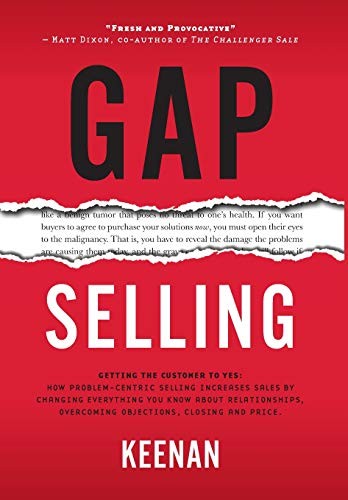Unlocking Business Potential: Strategic Insights from “Gap Selling”
“Gap Selling” by Keenan is a transformative guide for professionals seeking to enhance their business strategies and leadership skills. The book introduces innovative concepts and frameworks that empower individuals and organizations to identify and bridge gaps between their current state and desired outcomes. This summary distills the essence of Keenan’s insights, offering a structured approach to applying these principles in the modern business landscape.
Understanding the Gap: A New Perspective on Selling
At the heart of “Gap Selling” is the concept of identifying and closing the gap between where a business currently stands and where it aims to be. Keenan challenges traditional sales methodologies by emphasizing the importance of understanding the customer’s current situation and desired future state. This approach shifts the focus from selling products to solving problems, thereby creating value for both the seller and the buyer.
Keenan introduces the “Gap Selling Framework,” a structured method for diagnosing gaps and crafting solutions. This framework encourages sales professionals to delve deep into their clients’ businesses, uncovering underlying issues and opportunities for growth. By adopting this mindset, salespeople can position themselves as trusted advisors rather than mere vendors.
Core Frameworks and Concepts
The Gap Selling Framework
The Gap Selling Framework is a comprehensive model designed to help sales professionals identify and bridge the gap between a client’s current state and their desired future state. It is comprised of several key components:
-
Current State Analysis:
- Salespeople must thoroughly understand the client’s current operations, challenges, and limitations. This involves gathering detailed information about existing processes, resources, and performance metrics.
-
Desired Future State:
- Envisioning where the client wants to be is crucial. This involves identifying the client’s goals, aspirations, and success metrics. Understanding this vision allows salespeople to tailor solutions that align with the client’s objectives.
-
Gap Identification:
- The core of the framework, gap identification involves determining the differences between the current and desired states. This is where sales professionals uncover underlying issues that need resolution.
-
Solution Crafting:
- Once gaps are identified, sales professionals develop tailored solutions that address the client’s specific needs. This step requires creativity and a deep understanding of available resources and technologies.
-
Implementation and Follow-up:
- After a solution is proposed, successful implementation is key. Salespeople must work closely with clients to ensure solutions are effectively integrated and deliver the expected outcomes. Regular follow-ups help maintain momentum and adjust strategies as needed.
Comparison with Other Models
Keenan’s Gap Selling Framework shares similarities with other sales methodologies but stands out in its explicit focus on bridging gaps. For instance, in “SPIN Selling” by Neil Rackham, the emphasis is on identifying Situation, Problem, Implication, and Need-Payoff. While both models stress understanding client needs, Gap Selling uniquely highlights the transition from current challenges to future solutions.
Additionally, Daniel H. Pink’s “To Sell is Human” explores the idea of moving from problem solving to problem finding. Keenan’s approach mirrors this by not only addressing known issues but proactively identifying latent gaps that clients might not be aware of.
Real-World Application
Consider a technology firm facing declining sales despite a strong product lineup. Through the Gap Selling Framework, a sales professional might discover that the firm’s current marketing efforts are misaligned with evolving customer expectations. By identifying this gap, the salesperson can propose a realignment of marketing strategies and product positioning to better meet customer needs, thus driving sales growth.
Key Themes
1. Transition from Transactional to Diagnostic Selling
Keenan advocates for moving beyond transactional sales, where the focus is merely on closing deals, to a diagnostic approach that centers on understanding client needs. This shift necessitates a deep dive into the client’s business environment, akin to a doctor diagnosing a patient before treatment.
2. Building Credibility and Trust
In a competitive marketplace, credibility and trust are paramount. Keenan emphasizes the importance of sales professionals positioning themselves as knowledgeable advisors. This involves leveraging industry insights and staying abreast of trends to provide clients with valuable recommendations.
3. Overcoming Objections as Opportunities
Objections should not be viewed as barriers but as opportunities to deepen client engagement. By actively listening and empathizing with client concerns, sales professionals can address objections effectively and turn them into opportunities for reinforcing the value of their offerings.
4. Leadership’s Role in Driving Change
Leadership is crucial in fostering an environment conducive to gap selling. Keenan highlights the need for leaders to inspire innovation and encourage teams to embrace change. This aligns with John Kotter’s “Leading Change,” where leadership is seen as pivotal in navigating organizational transformations.
5. Embracing Digital Transformation
Keenan acknowledges the transformative power of technology in sales. By harnessing digital tools and data analytics, sales professionals can enhance their strategies and deliver more personalized solutions. This echoes themes in Geoffrey Moore’s “Crossing the Chasm,” where technology adoption is key to reaching mainstream markets.
Final Reflection
“Gap Selling” offers a comprehensive roadmap for professionals seeking to elevate their sales strategies and drive meaningful change. By focusing on identifying and closing gaps, Keenan provides a fresh perspective on selling that prioritizes problem-solving and value creation. Integrating insights from “SPIN Selling” and “To Sell is Human,” Keenan’s approach synthesizes these concepts into a practical framework that emphasizes the importance of understanding client needs and aspirations.
In the broader context of business and leadership, the principles of Gap Selling apply across various domains. For instance, in design thinking, the emphasis on understanding user needs parallels the diagnostic approach in sales. Similarly, in change management, identifying gaps and crafting solutions are crucial for successful transitions.
Ultimately, “Gap Selling” is not just about sales; it’s about fostering a mindset of continuous improvement and innovation. By adopting Keenan’s principles, individuals and organizations can unlock new opportunities for growth and achieve their desired outcomes, positioning themselves for long-term success in an ever-evolving business landscape.

